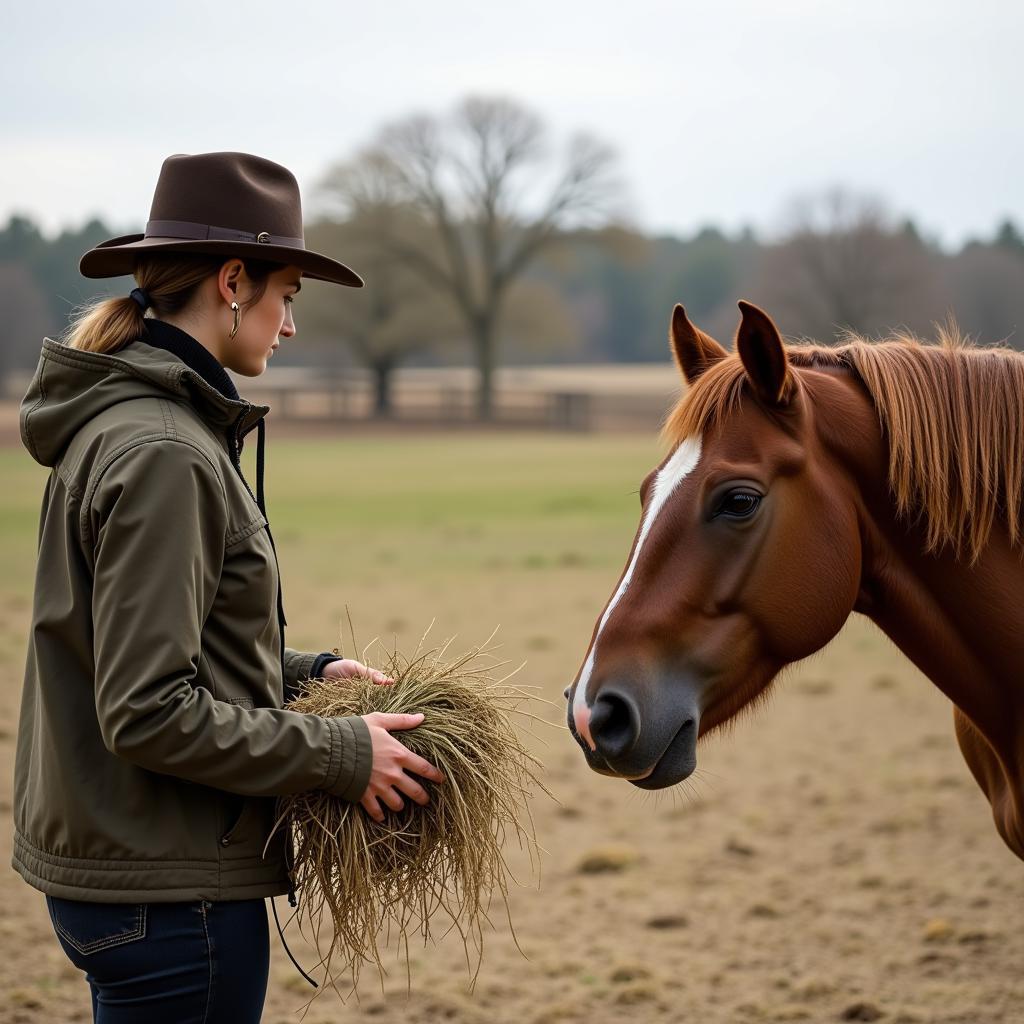Taming a wild horse is a challenging but rewarding endeavor. It requires patience, understanding, and a deep respect for the horse’s natural instincts. This guide will delve into the art of wild horse taming, covering essential techniques, necessary equipment, and the importance of building trust.
Understanding the Wild Horse
Before embarking on the taming process, it’s crucial to understand the psychology of a wild horse. These animals are prey animals, driven by instinct and a strong sense of self-preservation. They are not inherently aggressive, but their fear of humans can manifest as defensive behavior. Recognizing their body language, vocalizations, and social dynamics is key to successful interaction. Building a relationship based on mutual respect and trust is paramount. Remember, you are not “breaking” a wild horse, but rather gaining its confidence.
Building a Foundation of Trust
The initial stages of taming involve establishing a connection with the horse without overwhelming it. This can be achieved through gentle and consistent presence. Start by simply observing the horse from a safe distance, allowing it to become accustomed to your presence. Gradually decrease the distance, speaking softly and offering calming reassurance. Avoid sudden movements or loud noises that might startle the horse. Patience is paramount during this phase.
 Building Trust with a Wild Horse
Building Trust with a Wild Horse
The Art of Gentle Persuasion
Once the horse shows signs of accepting your presence, you can begin the process of gentle persuasion. This involves using positive reinforcement to encourage the horse to interact with you. Offer treats, such as carrots or apples, as a reward for positive responses. Use a soft, calm voice and gentle touch to desensitize the horse to human contact. Introduce the halter and lead rope gradually, allowing the horse to become comfortable with each new element. Never force or rush the process, as this can damage the trust you’ve built.
Essential Equipment for Taming
The right equipment is crucial for both your safety and the horse’s well-being. A sturdy round pen is essential for containing the horse during training sessions. A strong halter and lead rope are also necessary, along with a lunge whip for directing the horse’s movement. Protective gear, such as gloves and a helmet, should always be worn.
Working with a Professional Trainer
While it’s possible to tame a wild horse independently, seeking guidance from an experienced horse trainer is highly recommended. A professional can provide valuable insights and personalized advice tailored to the specific horse and situation. They can also help you avoid common mistakes and ensure the safety of both you and the horse. Taming a wild horse is a complex process, and professional guidance can greatly increase your chances of success.
Common Mistakes to Avoid
Avoid making sudden movements or loud noises that could frighten the horse. Don’t try to force the horse to do anything it’s not ready for. Be patient and consistent in your approach. Remember, building trust takes time and effort.
 Avoiding Common Mistakes in Horse Taming
Avoiding Common Mistakes in Horse Taming
Conclusion
Taming a wild horse is a long and complex process that requires patience, dedication, and a deep understanding of equine behavior. By building a foundation of trust, using gentle persuasion techniques, and employing the right equipment, you can successfully gain the confidence of a wild horse and embark on a rewarding partnership. Remember, Taming The Wild Horse is not about dominance, but about building a relationship based on mutual respect and understanding.
FAQ
- How long does it take to tame a wild horse? The time varies depending on the individual horse, but it can take months or even years.
- Is it dangerous to tame a wild horse? Yes, it can be dangerous if not done properly. Always prioritize safety and seek professional guidance when needed.
- What are the signs of a trusting horse? A trusting horse will approach you willingly, allow you to touch it, and follow your lead.
- What is the most important aspect of taming a wild horse? Patience and consistency are key.
- Can any horse be tamed? While most horses can be tamed, some may be more challenging than others due to temperament or past experiences.
- What are some common methods for taming a wild horse? Common methods include round pen training, groundwork exercises, and desensitization.
- How can I find a qualified horse trainer? Research local trainers and ask for recommendations from other horse owners.
Common Situations and Questions
- Scenario: The horse is showing signs of aggression. Solution: Back away slowly and reassess the situation. Consult with a professional trainer if needed.
- Scenario: The horse refuses to come near you. Solution: Be patient and continue to offer gentle encouragement and treats.
- Scenario: The horse is constantly testing boundaries. Solution: Establish clear boundaries and consistently enforce them.
Further Reading & Related Articles
- Understanding Horse Behavior
- Choosing the Right Horse Equipment
- Finding a Qualified Horse Trainer
For assistance, contact us at Phone: 0772127271, Email: [email protected], or visit us at QGM2+WX2, Vị Trung, Vị Thuỷ, Hậu Giang, Việt Nam. We offer 24/7 customer support.